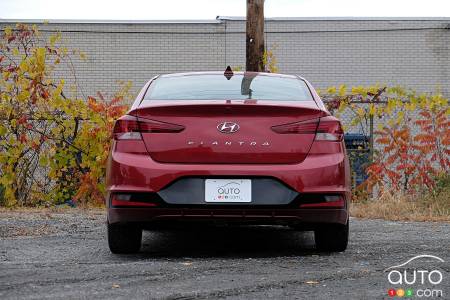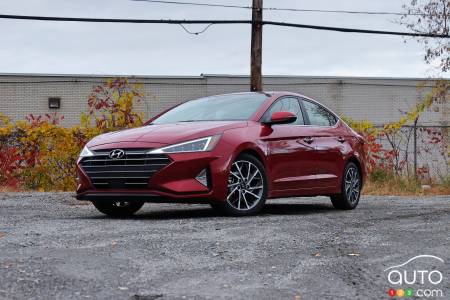This shouldn’t really be the case anymore, but I still have conversations with people who hesitate to place Hyundai on their short list when shopping for a new vehicle, because of… the Pony. Shedding its reputation for producing cheap, but cheaply constructed cars has been a long, sustained battle for the Korean automaker, but it’s a reputation it hasn’t deserved in quite some time.
Rather, the norm for many years now has been for the company to produce solid entries in the SUV segments like the Tucson and Santa Fe, and quality cars that compete with established big guns by offering high-quality construction and more equipment, for instance the Sonata and… the Elantra.
The Elantra specifically competes credibly versus others in its class, while offering enough space to enter into the conversation when considering a midsize sedan. Not quite, of course – the wide central console takes up more room in front than it should, and the back row is still a rather cramped space for larger adults – but in front anyways, the vibe occupants get is of a more expansive space than the typical compact car. And the same applies to the trunk space, at 407 litres quite generous for this sedan segment (though the Civic’s is still bigger).
Auto123 launches Shopicar! All new makes and models and all current promotions.
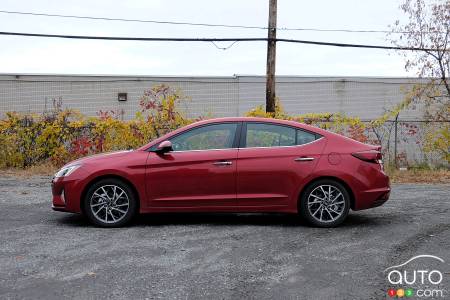
The surfeit of space and standard equipment offered in the Elantra is one factor that has helped the model stake out a place for itself in third spot in the category, behind only the twin juggernauts Honda Civic and Toyota Corolla. Pretty much the only thing holding the Elantra back from making a serious run at the two leaders is their reputations… and that of the Pony’s.
The versions
Without counting the Elantra Sport, five-door Elantra GT and esthetically enhanced Elantra GT N Line, Hyundai’s compact car comes in four trims: Essential, Preferred, Luxury and Ultimate.
Settle your choice on the entry-level Essential, and you get… the essentials. Which means 15-inch steel wheels, cloth seating, manual gearbox, 5-inch touchscreen (5!), no cruise (that’s an option), etc. The front seats are heated, as are the outside side mirrors, so there’s that.
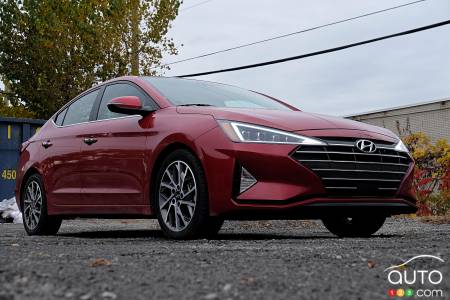
The Preferred trim is where your Elantra gets interesting if you want more than just a bare-bones way to get from A to B. For one thing the IVT (Intelligent Variable Transmission), standard here, brings with it a drive mode selection – although there’s no big jump in performance or driving excitement when you switch to Sport, unless enjoy persistent whining from the engine; best stick to Smart.
This trim comes with blind-sport collision warning with rear cross-traffic collision warning, as well as a heated steering wheel and 16-inch alloy wheels. You can also option in more safety functions, namely forward collision-avoidance assist, forward collision warning, lane keeping assist, lane departure warning and hillstart assist control. The screen balloons to a more acceptable 7 inches (which integrates Android Auto and Apple CarPlay), and the steering wheel and shift knob wrap themselves in leather (OK, someone else did that).
The Luxury trim gets 17-inch alloy wheels, dual-zone automatic climate control, two USB ports, leather seating and a distinct gloss-black centre fascia.
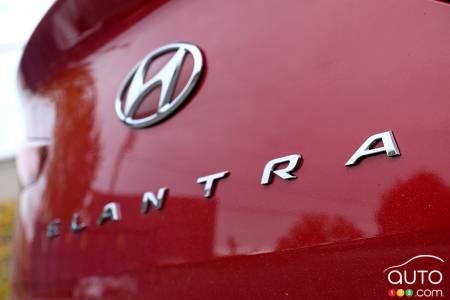
The top-end Ultimate gets an even bigger screen (8 inches), premium Infinity audio system, 4-inch TFT cluster display, 8-way power-adjustable driver’s seat (with lumbar support), heated rear seats, wireless charging pad, adaptive cruise control, forward collision-avoidance assist with pedestrian detection and the Safe Exit Alarm that will help you avoid dooring cyclists and such. Also, in this version the headlights and tail lights are LED.
The powertrain
All of the 2020 Hyundai Elantra sedan trims comes with a solid if unexciting 2.0L 4-cylinder engine under the hood that develops 147 hp. Beyond that, if you go for the Elantra Sport, you get a 1.6L turbo that’s mildly spicier and delivers 201 hp.
No longer part of the product offering in 2020 is the available 6-speed automatic transmission; in its stead we get an unadventurous but competent CVT unit (which the company calls an IVT, for Intelligent Variable Transmission, as mentioned above. Whatever). The manual gearbox can still be had as the base transmission.
The 2.0L engine takes the place of a 1.8L unit that had its share of issues over the years, and we can only hope that won’t be the case with its successor.
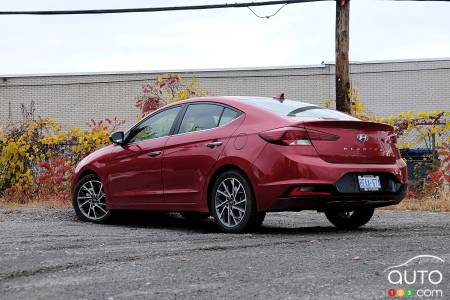
On the road
Overall, the 2020 Elantra performs like it looks – solid, well put-together, not particularly exciting. The CVT (sorry, IVT) does better than you might fear, with little of the elastic loosey-goosey-ness of many units of this kind that make for screaming engines and bleeding ears. You’ll get that here too if you push the Elantra hard, but that’s not what this car is meant for. Be chill and you’ll be fine here, especially since the brute power from the engine is sufficient for this amount of car.
Steering is not exactly tight and crisp, but nor does it dishonour itself. Braking is solid and I found no reason to complain there. And the Elantra proves relatively nimble in cornering, thanks to what feels like a fairly stiff chassis and good quality of construction all around.
I found the interior setup quite to my liking as well, with all the required functions available via buttons within easy reach, so as to avoid having to take eyes of the road and onto the touchscreen. I particularly appreciated how easily accessible the buttons for the seat and steering-wheel heating functions are.
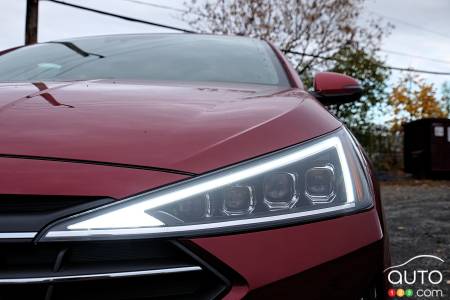

Fuel consumption
Some will lament the arrival of a CVT (excuse me, IVT) in the 2020 Elantra, but the fact is not only is it perfectly competent, it also does help bring down fuel consumption, at least on paper: the 2019 Elantra had a combined 7.4L/100 km rating, but its successor clocks in at an excellent 6.8L/100 km. On paper. My week of driving, admittedly skewed to city driving, resulted in a combined total of 8.6L/100 km.
Pricing
The price of the 2020 Elantra gets only the tiniest of nudges upwards and is now $17,149, up from $16,999. Another $1,700 gets you the Essential but with IVT. Then the Preferred starts at $20,599, the Luxury at $24,299 and the Ultimate at $27,599.
Beyond the four trims of the regular Elantra sedan, you can also opt for the GT 5-door version ($20,599), or the Elantra Sport that retails starting at $25,499. Above and beyond those you get the Elantra GT N Line, all decked out for sporty adventure, and priced at $27,199.
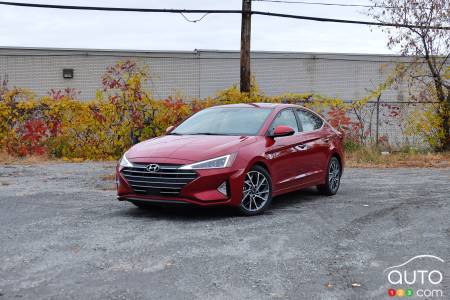
Make no mistake, the Elantra is still a high-value proposition. But there’s some question as to whether Hyundai can continue to claim the advantage in the more-bang-for-buck department for much longer. The Civic and Corolla, for instance, offer more standard equipment than ever before and you could even argue that they’ve erased the gap between them and the Korean compact sedan. Meanwhile the Mazda3 offers AWD as an option, a sure selling point with Canadians, and Nissan is just now rolling out its redesigned new Sentra, nicely wrapped and all stuffed with new tech and equipment.
We like
Quality of construction
Good roster of equipment on higher trims
Good engine power
Spacious interior, especially in front
Interior ergonomics
We like less
Base model is pretty bare bones
Sport mode is a non-factor
No hybrid option
Where art thou, AWD?
The competition
Honda Civic
Mazda Mazda3
Nissan Sentra
Toyota Corolla
Volkswagen Jetta
